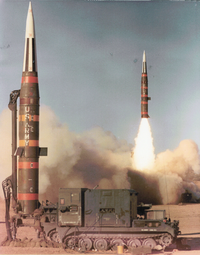Pershing 1a
| Pershing 1 | |
|---|---|

Pershing round 32 launched from Hueco Range, Texas by A Battery, 2nd Battalion, 44th Field Artillery, targeted for White Sands Missile Range on 20 August 1963
|
|
| Type | Surface-to-surface guided missile |
| Place of origin | United States |
| Service history | |
| In service | 1962–1969 |
| Used by |
|
| Production history | |
| Designer | The Martin Company |
| Designed | 1958–1960 |
| Manufacturer |
The Martin Company Martin Marietta |
| Produced | 1960–1969 |
| No. built | 754 MGM-31A missiles |
| Specifications | |
| Weight | 10,275 pounds (4,661 kg) |
| Length | 34.6 feet (10.5 m) |
| Diameter | 40 inches (1 m) |
| Blast yield |
|
|
|
|
| Engine |
|
|
Operational
range |
460 miles (740 km) |
| Boost time | 77.3 seconds |
| Speed | Mach 8 |
|
Guidance
system |
Eclipse-Pioneer ST-120 inertial guidance |
|
Steering
system |
Jet vanes, air vanes |
| Accuracy | 1,310 feet (400 m) circular error probable |
|
Launch
platform |
M474 transporter erector launcher |
| Pershing 1a | |
|---|---|

Pershing 1a launched from the Eastern Range, Cape Canaveral Air Force Station, Launch Complex 16 by C Battery, 3rd Battalion, 84th Field Artillery on 26 October 1976
|
|
| Type | Surface-to-surface guided missile |
| Place of origin | United States |
| Service history | |
| In service | 1969–1991 |
| Used by |
|
| Production history | |
| Designer | Martin Marietta |
| Designed | 1965–1969 |
| Manufacturer | Martin Marietta |
| Produced | 1969 |
| No. built | 754 MGM-31A missiles |
| Specifications | |
| Weight | 10,275 pounds (4,661 kg) |
| Length | 34.6 feet (10.5 m) |
| Diameter | 40 inches (1 m) |
| Blast yield |
|
|
|
|
| Engine |
|
|
Operational
range |
460 miles (740 km) |
| Boost time | 77.3 seconds |
| Speed | Mach 8 |
|
Guidance
system |
Eclipse-Pioneer ST-120 inertial guidance |
|
Steering
system |
Jet vanes, air vanes |
| Accuracy | 1,310 feet (400 m) circular error probable |
|
Launch
platform |
M790 erector launcher |
| Transport | M757 5-ton tractor |
The MGM-31A Pershing was the missile used in the Pershing 1 and Pershing 1a field artillery missile systems. It was a solid-fueled two-stage ballistic missile designed and built by Martin Marietta to replace the PGM-11 Redstone missile as the primary nuclear-capable theater-level weapon of the United States Army and replaced the MGM-1 Matador cruise missiles operated by the German Air Force. Pershing later replaced the European-based MGM-13 Mace cruise missiles deployed by the United States Air Force and the German Air Force. Development began in 1958, with the first test missile fired in 1960, the Pershing 1 system deployed in 1963 and the improved Pershing 1a deployed in 1969. The U.S. Army replaced the Pershing 1a with the Pershing II Weapon System in 1983 while the German Air Force retained Pershing 1a until all Pershings were eliminated in 1991. The U.S. Army Missile Command (MICOM) managed the development and improvements while the Field Artillery Branch deployed the systems and developed tactical doctrine.
The Martin Company
George Bunker, president of the Martin Company, paid a courtesy call on General John Medaris, USA, of the Army Ballistic Missile Agency (ABMA) at Redstone Arsenal, Alabama in 1956 . Medaris noted that it would be helpful to the Army if there was a missile plant near the Air Force Missile Test Center (present day Cape Canaveral Air Force Station) in Florida. The Martin Company subsequently began construction of their Sand Lake facility in Orlando, Florida which opened in late 1957. Edward Uhl, the co-inventor of the bazooka, was the vice-president and general manager of the new factory, which continues to operate today as the Lockheed Martin Missiles and Fire Control facility.
...
Wikipedia
